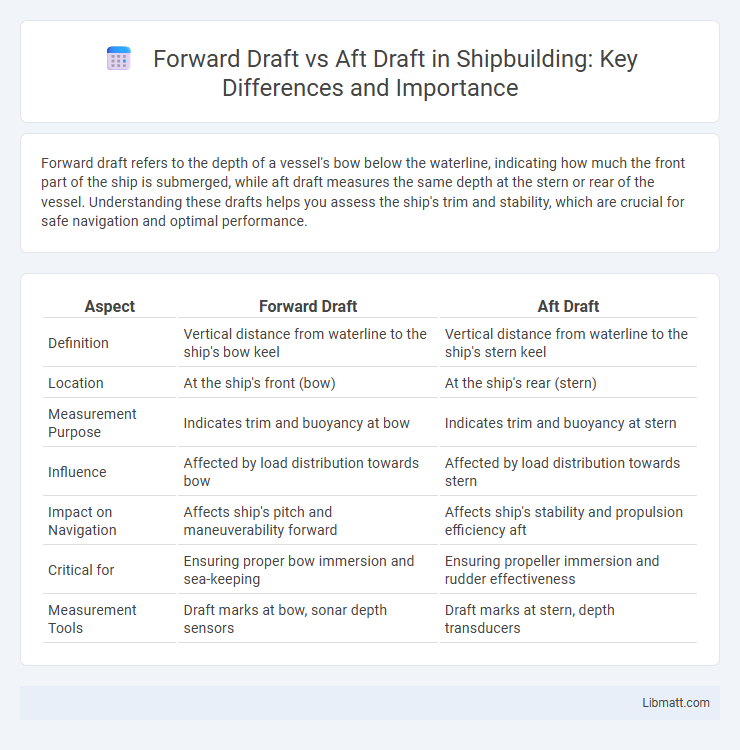Forward draft refers to the depth of a vessel's bow below the waterline, indicating how much the front part of the ship is submerged, while aft draft measures the same depth at the stern or rear of the vessel. Understanding these drafts helps you assess the ship's trim and stability, which are crucial for safe navigation and optimal performance.
Table of Comparison
| Aspect | Forward Draft | Aft Draft |
|---|---|---|
| Definition | Vertical distance from waterline to the ship's bow keel | Vertical distance from waterline to the ship's stern keel |
| Location | At the ship's front (bow) | At the ship's rear (stern) |
| Measurement Purpose | Indicates trim and buoyancy at bow | Indicates trim and buoyancy at stern |
| Influence | Affected by load distribution towards bow | Affected by load distribution towards stern |
| Impact on Navigation | Affects ship's pitch and maneuverability forward | Affects ship's stability and propulsion efficiency aft |
| Critical for | Ensuring proper bow immersion and sea-keeping | Ensuring propeller immersion and rudder effectiveness |
| Measurement Tools | Draft marks at bow, sonar depth sensors | Draft marks at stern, depth transducers |
Introduction to Ship Drafts
Forward draft refers to the vertical distance from the waterline to the bottom of the ship's bow, while aft draft measures the same distance at the stern. These drafts are critical for assessing a vessel's trim, stability, and safe navigation in varying water depths. Accurate measurement of forward and aft drafts helps optimize cargo loading and ensures compliance with maritime safety regulations.
What is Forward Draft?
Forward draft refers to the vertical distance between the waterline and the lowest point at the bow (front) of a ship. It is a critical measurement used for assessing a vessel's trim, stability, and ensuring safe navigation in shallow waters. Accurate forward draft readings help prevent grounding and optimize fuel efficiency during voyage planning.
Understanding Aft Draft
Aft draft refers to the vertical distance between the waterline and the lowest point at the stern of a ship, indicating how deeply the rear of the vessel sits in the water. Understanding aft draft is crucial for assessing the ship's stability, trim, and overall performance, as uneven drafts can affect maneuverability and fuel efficiency. Accurate measurement of the aft draft, along with the forward draft, ensures safe navigation and optimal load distribution.
Key Differences Between Forward and Aft Draft
Forward draft refers to the vertical distance between the waterline and the bow of the vessel, while aft draft measures the same distance at the stern. The key differences impact vessel trim and stability, with forward draft affecting the ship's ability to navigate shallow waters at the bow and aft draft influencing propulsion efficiency and steering. Understanding your ship's forward and aft draft is crucial for safe loading, optimal performance, and maintaining balance during voyages.
Importance of Accurate Draft Measurements
Accurate measurements of forward draft and aft draft are critical for maintaining a vessel's stability, trim, and safety during navigation. Proper draft readings ensure optimal weight distribution and prevent excessive stress on the hull, which is vital for operational efficiency and regulatory compliance. Precise draft data supports safe loading, cargo management, and reduces the risk of grounding or capsizing incidents.
Factors Affecting Forward and Aft Drafts
Forward and aft drafts are influenced by vessel loading distribution, ballast water management, and cargo weight placement, which alter the ship's trim and stability. Environmental forces such as waves, wind, and current also impact the draft measurements by causing the ship to pitch or list. Structural considerations, including hull shape and load line regulations, ensure safe draft limits are maintained forward and aft during navigation.
Implications for Stability and Trim
Forward draft and aft draft refer to the water depths at the bow and stern, respectively, directly impacting a vessel's stability and trim. A greater forward draft can cause a bow-down trim, affecting steering responsiveness and increasing drag, while a deeper aft draft leads to a stern-down trim, influencing propeller efficiency and fuel consumption. Understanding these drafts allows you to optimize vessel balance for improved stability, safety, and operational performance.
Impact on Vessel Performance
Forward draft and aft draft significantly influence vessel performance by affecting stability, speed, and fuel efficiency. A deeper forward draft increases water resistance at the bow, potentially reducing speed and maneuverability, while a greater aft draft can enhance propulsion efficiency but may cause increased stern squat. Balancing your vessel's drafts optimizes hydrodynamic flow, improving overall handling and operational effectiveness.
Safety Considerations for Varying Drafts
Forward draft and aft draft variations significantly influence a vessel's stability and maneuverability, critical for maritime safety. Accurate monitoring prevents excessive trim, reducing the risk of structural stress, compromised steering, and inefficient propulsion. Maintaining optimal draft balance ensures safe navigation, especially in shallow waters and adverse weather conditions.
Conclusion: Choosing the Right Draft Approach
Selecting between a forward draft and an aft draft depends on vessel stability, cargo distribution, and operational conditions. Forward drafts improve maneuverability in rough seas by enhancing bow immersion, while aft drafts offer better propulsion efficiency and trim balance in calm waters. Assessing the ship's load and navigation environment ensures the optimal draft approach for safety and performance.
Forward draft vs aft draft Infographic

 libmatt.com
libmatt.com